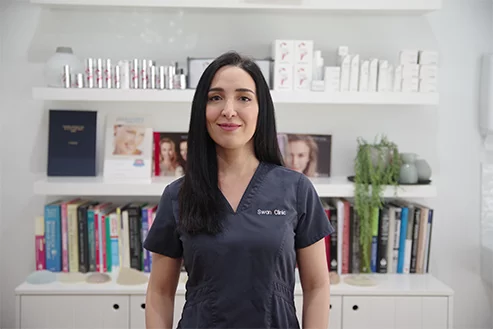BLEPHAROPLASTY (EYELID SURGERY)
What is an Upper Blepharoplasty?
Upper blepharoplasty is a surgical procedure involving the upper eyelids. The operation may include the removal or repositioning of tissue in the upper eyelid area. Hooding at the outer corners of the eyes can also be addressed during the procedure when clinically appropriate.
If the upper eyelid skin touches the eyelashes and obstructs vision, a Medicare item number may apply.
How to Achieve Optimal Outcomes
In the past, blepharoplasty surgery often involved removing significant amounts of skin and fat, which in some cases resulted in a hollow appearance around the eyes. Current techniques focus on repositioning tissues rather than excessive removal, aiming to preserve eyelid structure and function. This approach is based on updated anatomical knowledge and clinical experience to support improved surgical results.
How to Get the Best Results
A thorough assessment is essential before surgery to identify any underlying conditions that may affect the outcome. These include eyebrow ptosis (where the frontalis muscle compensates to lift the eyebrows), eyelid ptosis (which may require a separate surgical repair), and eyelid asymmetry. Addressing these factors during surgery can help achieve the intended surgical goals.
What is a Browpexy?
A browpexy is a surgical technique used to help raise and support the brow by securing it internally through an incision in the upper eyelid skin. This procedure is often performed alongside an upper blepharoplasty. Recovery may take longer than a standard upper blepharoplasty because sutures are anchored to the bone, and additional sutures are used to help define the upper eyelid crease.
Brow Lift
A brow lift can be performed using different techniques:
- Hairline brow lift: The incision is made within the hairline to lift the brow.
- Direct brow lift: The incision is made along the eyebrow line, with the scar hidden within the brow hairs. This method may require makeup such as feathering or brow pencil to further conceal the scar.
- Browpexy: This technique involves placing deep sutures to support and lift the brow through an incision in the upper eyelid.
Lower Blepharoplasty
Lower blepharoplasty is a surgical procedure involving the lower eyelids. It may include the removal or repositioning of fat and the reduction of redundant tissue in the lower eyelid area. The procedure can be performed on its own or in combination with other clinically appropriate treatments. The operation focuses on adjusting the tissues of the lower eyelids based on individual anatomical considerations.
Typically, a lateral canthopexy or canthoplasty is performed alongside the lower blepharoplasty. These techniques support and anchor the outer corner of the eye, helping to maintain the results over time.
Procedure
This procedure is performed under general anaesthetic or sedation at The Swan Clinic or in hospital. It takes 1-2 hours and is performed as day stay. The sutures are removed after one week.
Potential Risks – Upper Blepharoplasty
As with any surgery, this procedure carries general and procedure-specific risks, including:
- Infection at the incision site, which may require antibiotics or further treatment
- Bleeding or haematoma, which may need medical intervention
- Scarring, typically hidden in the natural crease of the eyelid, but in rare cases may be raised, thickened, or pigmented
- Asymmetry in eyelid shape, contour, or crease position
- Dry eyes, tearing, or irritation, which may be temporary or persist longer
- Temporary blurred vision or light sensitivity due to swelling
- Eyelid tightness, pulling sensation, or difficulty fully closing the eyelids (usually temporary, but in rare cases may be persistent)
- Changes in sensation, such as numbness or tingling near the eyelids or brow
- Excess removal of skin, which can lead to eyelid retraction or difficulty blinking (rare and may require revision)
- Allergic reaction to dressings, sutures, or medications
- Anaesthesia-related risks, especially with sedation or local anaesthetic, including allergic reaction or other complications
Recovery and Aftercare – Upper Blepharoplasty
Healing after upper eyelid surgery is generally well tolerated, but outcomes and recovery time can vary between individuals. Below is a general guide to the recovery process:
- Swelling and bruising around the eyes and upper face are common, typically peaking in the first few days and improving over 1–2 weeks
- Mild discomfort, tightness, or dryness in the eyelids is normal and can usually be managed with prescribed or over-the-counter pain relief
- Cold compresses may be used in the first 48 hours (as directed) to help reduce swelling and bruising
- Keeping the head elevated, including during sleep, is recommended to minimise swelling
- Eye drops or ointment may be prescribed to keep the eyes lubricated and prevent dryness
- Avoid rubbing the eyes, wearing contact lenses, or using eye makeup until approved by your surgeon
- Strenuous activity, bending, or heavy lifting should be avoided for at least 1–2 weeks
- Sutures (if non-dissolvable) are typically removed within 5–7 days
- Sun protection is essential after surgery, as the eyelid skin may be more sensitive to sun exposure
- Smoking and alcohol should be avoided during recovery, as they can delay healing and increase risk of complications
- Scars may remain pink or slightly raised for several weeks but generally fade over time
- Final results may take months to become apparent, as swelling subsides and eyelid contours settle
- Follow-up appointments are important to monitor healing and address any concerns
If you have any questions or wish to discuss blepharoplasty options, please contact our clinic to schedule a consultation with Dr Reema Hadi.
If you would like more information on Blepharoplasty, you can visit the Australian Society of Plastic Surgery

